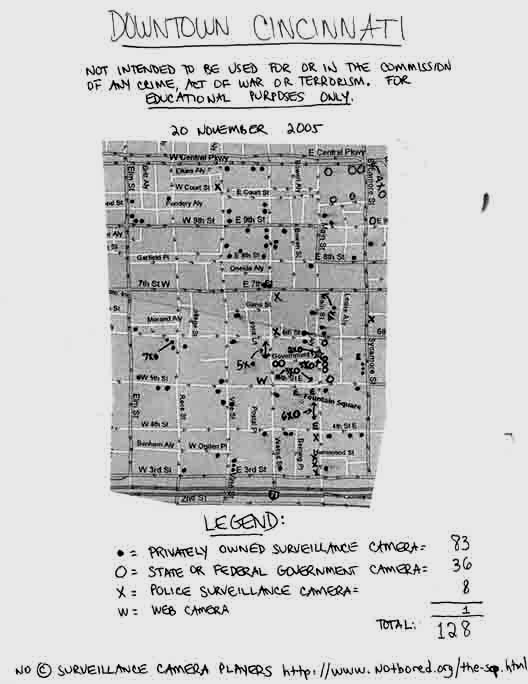

Between 19 and 22 November 2005, Bill Brown of the Surveillance Camera Players (New York) was in Cincinnati, Ohio, thanks to the efforts of Kim, an art history professor at the University of Cincinnati. An "urban" campus, the University of Cincinnati is quite separate from (to the north of) the city's downtown area, which is only populated from 9 am to 5 pm during the work week, and is completely empty during the week-ends. In between the two areas lies the "Over-The-Rhine" neighborhood, a small black ghetto that includes entire blocks of abandoned houses. No doubt students only come downtown to see Cincinnati Reds baseball or Cincinnati Bengals football games, which are played in water-front stadiums along the Ohio River. Otherwise, they stay away. Cincinnati is supposedly the seventh most-segregated city in the USA. It looks like it.
During the afternoon of Saturday the 19th and the morning of Sunday the 20th, Bill mapped out a central portion of downtown Cincinatti: everything between Central Parkway to the north and 3rd Street to the south; between Elm Street to the west and Sycamore Street to the east. He would have gone further north, up into Over-The-Rhine, had there been more time.
Within this 40-square-block area, Bill located and maapped out a total of 128 surveillance cameras: 83 on privately owned buildings; 36 on buildings owned by the federal government or the State of Ohio; 8 on city-owned poles or buildings ("police cameras"); and 1 web cam. These results are similar to the ones Bill found in another Midwestern city, Chicago, where there are also three surveillance cameras per city block. (In New York City, there are at least four per block.)
The state/federal government cameras in Cincinnati are located in one of two areas: the courthouse/jail complex at Sycamore and Central Parkway (9 of 36), or the John Weld Peck Federal Building at 550 Main Street (the remaining). The cameras at the latter location are obviously newer and may well have funded by post-September 11th, Homeland Security funds: they hang, dark and globe-shaped, three on a single pole, like coconuts.
First installed in October 1998, the police cameras are very sophisticated devices: they are actually remote-controled web cams, which -- at $25,000 each -- continuously broadcast digital images that can be viewed in real time anywhere an officer has any kind of web-enabled device (BlackBerry, cell phone, laptop, computer terminal, etc) and the right username/password sequence. These cameras' abilities to pan, tilt and zoom are truly spectacular (and alarming): to see them on display, visit the official Fountain Square Web Cam, which uses the very same technology to broadcast its images.
To comply with State law, if not to mollify the fears of the people of Cincinnati, the police came up with procedures for the "accountability, processing, storage and release" of evidence obtained by surveillance cameras. But, as adopted April 1999 and renewed August 2004, Section 12.538 Surveillance Cameras does not mention, let alone detail, 1) the training that camera-monitors must receive before they can use the equipment; 2) the background checks that potential camera-monitors must undergo and pass before they can be trained to become camera-monitors; 3) the First, Fourth and Fifth Amendments to the U.S. Constitution, and what rights they protect; and 4) the penalties, both administrative and criminal, that a camera-monitor faces if he or she breaks the law.
As it turns out, these police cameras are not very effective in "fighting crime": an August 1999 study by the criminal justice faculty at the University of Cincinatti found "a pattern of initial deterrence and then gradual increases in anti-social behavior as people become used to the video cameras," a portion of the study concluded. As part of that initial deterrence, crime displacement was a by-product. "In Over-The-Rhine," the Cincinatti Post reported on 28 January 2000, "the camera seemed just to push criminal activity to other areas." Perhaps this is why, seven years later, there are only 8 police cameras -- 8 cameras that appear from their placement to be operated by the police, one can't be absolutely sure -- in downtown Cincinnati.
At 2 pm, on Sunday 20 November, and right in front of the federal building, Bill started a walking tour based upon the map he'd just finished and photocopied. Because that walking tour had been publicized in advance (by the Cincinnati City Beat), a cop had the place staked out, and radio'd his superior as soon as people started to together. After Bill began speaking, a team of officers -- lead by the lieutenant on duty at the time -- approached the walking tour (about 20 people) and, stopping a step or two behind the circle of people, started listening to what was being said. Of course, Bill saw the cops, invited them into the circle, and continued his presentation.
After five or ten minutes, the lieutenant (one Rusell Neville) interrupted Bill to announce that he'd heard enough, that he and his men were leaving, and that, based on what he had seen, he didn't think there would be any problems with our tour after he'd left, especially if the tour-participants with cameras didn't photograph anything inside the federal building. (There have obviously been battles between the Cincinnati Police Department and the American Civil Liberties Union -- battles that the ACLU has won -- over the citizen's constitutional right to photograph anything he or she wants as long as he or she is standing on public property.) True to his word, the lieutenant and his fellow white-shirted officers departed, never to be seen again. Another officer -- a corporal if memory serves -- returned to listen, and even asked for (and received) a copy of the map, because, he said, he finds the subject "interesting."
By e-mail SCP@notbored.org
By snail mail: SCP c/o NOT BORED! POB 1115, Stuyvesant Station, New York City 10009-9998